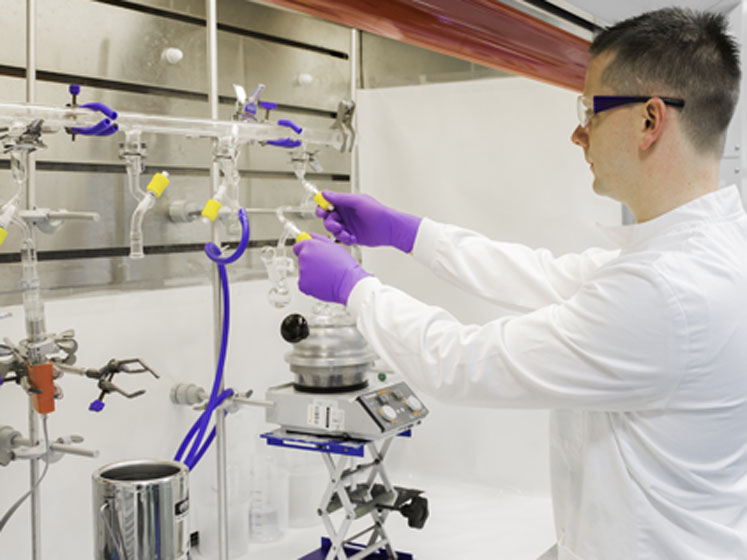From a safety perspective, advances in tracing techniques are exceptionally important for the testing required for everyday and specialty chemicals. From an environmental perspective, they are crucial in terms of paving the way forward for sustainably integrating chemicals into the ecosystem. James Stevenson, a radiochemist with Almac Sciences, reports.
About C-14
C-14 is a naturally occurring radioactive isotope of carbon. Scientists often incorporate C-14 into organic compounds for environmental studies; doing so allows them to track its movements and transformations within various ecosystems.
This approach enables the researcher to gain valuable insights into the degradation of these compounds, as well as their accumulation and transport throughout different environmental media.
Together, these findings are used to aid the assessment of environmental health and in the formulation of sustainability and pollution control strategies.
Incorporating C-14 into radiolabelling
Incorporating C-14 into a technique called radiolabelling represents the gold standard for safety testing. This process involves tagging specific organic compounds with a radioactive marker that’s incorporated into the molecular structure of the compound of interest.
This enables precise tracking of these compounds as they traverse various environmental biomes, including soil, water and air.
The introduction of a C-14 marker into the compound does not generally alter its natural behaviour in the environment, so monitoring of the compound’s movement and interaction within different ecological systems can be done with full confidence that an accurate result will be collected.
The capabilities of this technique have been significantly enhanced by the evolution of detection and analysis methods for C-14 compounds. Techniques such as liquid scintillation counting and accelerator mass spectrometry have been pivotal in this progress.
These methods have greatly enhanced the sensitivity and accuracy of C-14 measurements, allowing for much finer resolution in tracing studies.

These improvements enable researchers to detect even minute quantities of C-14, facilitating more detailed and precise investigations into the behaviour and fate of labelled compounds in the environment.
This heightened level of precision leads to a deeper understanding of intricate ecological interactions and processes, giving rise to a widened scope and impact of environmental research.
C-14 tracing is instrumental in environmental science, particularly for understanding pollutant degradation. When a pollutant is labelled with C-14, researchers can track the degradation pathways, rates and by-product formation in various environmental contexts.
This detailed information is used to evaluate the environmental impact of pollutants. By understanding how these substances break down in nature, a full assessment of the longevity and potential harm to ecosystems can be done.
Additionally, the information can be used to develop effective strategies for pollution mitigation and environmental protection. This leads to a more sustainable way to manage and reduce the adverse effects of pollutants in the environment.
C-14 can also be used to great effect in the study of the global carbon cycle, particularly in terms of understanding carbon sequestration and release in a wide range of ecosystems.
C-14 tracers are used in this context to accurately quantify the rates at which carbon is sequestered or released back into the atmosphere. These studies are crucial for a comprehensive understanding of the carbon cycle, a key factor influencing climate change.
The learnings from these studies are used by scientists to evaluate the effectiveness of natural and artificial carbon sinks in the environment and help to inform the development of strategies to mitigate the impact of climate change.
C-14 tracing is also used in soil and water systems. In this context, it is used to examine the interactions of organic compounds with soil particles, their mobility within the environment and their bioavailability to flora and micro-organisms.

This method sheds light on the movements and uptake of important compounds in a variety of contexts, providing scientists with detailed insights into soil health and nutrient cycling.
Understanding these interactions is key for those wishing to assess soil and water systems’ ecological balance and productivity. Moreover, this technique aids in the identification of potential risks associated with pollution, guiding strategies to manage soil and water quality, thereby improving environmental health and sustainability.
Another application of this technique is in environmental impact assessment, wherein data is collected on the persistence and mobility of organic compounds.
Using a C-14 tracer, scientists can determine the longevity and movement of pollutants in a number of ecosystems, providing insight into their long-term environmental effects.
Such detailed information is vital for a comprehensive evaluation of the impact of these substances on ecological systems. The data derived from C-14 tracing can be used to inform the development of effective regulations and guidelines to use, manage and dispose of pollutants.
Costs and challenges
Despite the many benefits of this important technique, C-14 tracing encounters several challenges; a primary hurdle being the high cost associated with synthesising the C-14 labelled compounds.
This can limit its accessibility and can prevent widespread use in research. Additionally, with the use of radioactive material, specialised equipment is required for the detection and analysis of the data obtained.
Another significant challenge is the handling of radioactive materials inherent in C-14 studies, which brings with it the requirement for strict safety protocols and regulatory compliance. This adds to the complexity and cost of conducting such environmental tracing studies.
The future of C-14 environmental tracing appears to be very promising, owing to the ever-improving nature of technology and methodology. As techniques become more cost-effective and efficient, the application of C-14 tracing in environmental research is set to broaden significantly.
The developments are likely to make C-14 tracing a more accessible and practical option for a wider range of studies, enhancing our understanding of ecological processes and pollutant behaviours.
This technique will be vital in terms of understanding and addressing environmental conservation and management challenges.
Conclusion
C-14 environmental tracing provides an invaluable way to understand the dynamics of organic compounds in the environment. It provides essential insights into the degradation and movement of pollutants and plays a crucial role in carbon cycling studies.
Despite its challenges, the continued advancement in this field promises to yield significant contributions to environmental science and protection.




